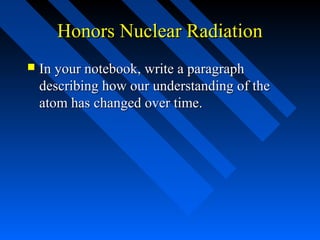
Honors Nuclear Radiation's Atomic History
- 1. Honors Nuclear Radiation In your notebook, write a paragraph describing how our understanding of the atom has changed over time.
- 2. Getting Inside the Atom Atomic Structure
- 3. Dalton’s Atomic Theory in 1808 All matter is composed of extremely small particles called atoms. Atoms of a given element are identical in size, mass, and other properties; atoms of different elements differ in size, mass, and other properties. Atoms cannot be subdivided, created, or destroyed.
- 4. Dalton’s Atomic Theory, continued Atoms of different elements combine in simple whole-number ratios to form chemical compounds. In chemical reactions, atoms are combined, separated, or rearranged.
- 6. Modern Atomic Theory Not all aspects of Dalton’s atomic theory have proven to be correct. We now know that: • Atoms are divisible into even smaller particles. • A given element can have atoms with different masses. Some important concepts remain unchanged. • Atoms of any one element differ in properties from atoms of another element. • All matter is composed of atoms.
- 7. Discovery of the Subatomic Particles For the better part of 70 years Dalton’s ideas remained unchanged. In 1897, using Cathode ray tubes, J.J. Thomson reported that cathode rays were made up of negatively charged particles in motion.
- 8. Figure 3.7: Schematic of a cathode ray tube.
- 10. Plum Pudding model of an atom.
- 11. Discovery of the Atomic Nucleus More detail of the atom’s structure was provided in 1911 by Ernest Rutherford and his associates Hans Geiger and Ernest Marsden. The results of their gold foil experiment led to the discovery of a very densely packed bundle of matter with a positive electric charge. Rutherford called this positive bundle of matter the nucleus.
- 12. Figure 3.5: Rutherford’s experiment.
- 14. Figure 3.6: Results of foil experiment if Plum Pudding model had been correct.
- 15. Figure 3.6: Actual Results.
- 16. Discovery of the Proton 1919 Ernest Rutherford
- 18. Discovery of the neutron 1932 James Chadwick
- 20. The Structure of the Atom An atom is the smallest particle of an element that retains the chemical properties of that element. The nucleus is a very small region located at the center of an atom. The nucleus is made up of at least one positively charged particle called a proton and usually one or more neutral particles called neutrons.
- 21. Fundamental Particles (The Standard Model)
- 23. Part I Fundamental Particle – The Meaning
- 25. It is understood that the universe is composed of particles.
- 26. Currently, the leptons and quarks appear to qualify as the true fundamental/elementary particles; meaning without structure.
- 27. The organization of known fundamental particles – The Standard Model
- 29. “The standard model of particle physics is a theory which [currently] describes three of four known fundamental interactions between the elementary particles that make up all matter…
- 30. It is a quantum field theory developed between 1970 and 1973 which is consistent with both quantum mechanics and special relativity.”
- 31. “…the standard model falls short of being a complete theory of fundamental interaction, primarily because of it’s lack of inclusion of gravity, the fourth known fundamental interaction.”
- 32. The particle nature of the standard model consists of two groups: - Matter Particles - Force-Mediating Particles
- 33. Matter Particles
- 36. The matter component of the Standard Model is comprised of twelve particles.
- 38. These particles all have an intrinsic spin value of ½, making them conform to the Pauli Exclusion Principle.
- 40. All matter particles of the Standard Model also have corresponding antimatter particles. These particles breakdown into groups of quarks (up, down, strange, charm, top, and bottom) and leptons (electron, muon, tau, and corresponding neutrinos). Quarks and leptons are further grouped into sets known as generations.
- 41. Quarks carry color charges (red, blue, or green) so they participate in strong interactions.
- 42. The up, charm, and top quarks carry the electric charge (+2/3). The down, strange, and bottom quarks carry the electric charge (-1/3). This allows the quarks to participate in electromagnetic interaction.
- 43. Leptons are color neutral and do not participate in strong interaction.
- 44. The electron, muon, and tau particles carry the electric charge (-1) and participate electromagnetic interaction.
- 45. Neutrinos have no electric charge and do not participate in electromagnetic interactions.
- 46. Quarks and leptons carry flavor charges and participate in weak nuclear interactions.
- 51. Force-mediating particles of the Standard Model group into three categories that correspond with three of the four fundamental interactions. All three mediating particles are bosons and have intrinsic spins of (1).
- 53. This allows these particles to not conform to the Pauli Exclusion Principle.
- 54. Photons are electromagnetic force mediators involving charge particles. Photons are considered massless particles.
- 55. W+, W-, and Zo gauge bosons are weak nuclear mediators involving particles of different flavors (quarks and leptons). W+, W-, and Z0 bosons are massive particles.
- 56. Gluons are strong nuclear force- mediators involving color charged particles (quarks). Gluons are considered massless particles.
- 57. Part III The Higgs particle – The Challenge
- 59. The Standard Model predicts the existence of one more particle known as the “Higgs boson.” The Large Hadron Collider (LHC) at CERN is hoped to confirm the existence of the Higgs boson in the near future.
- 60. Quarks • Protons and neutrons are composed of quarks. • There are six different types of quarks. u up (+2/3) d down (-1/3) t top (truth) b bottom (beauty) c charm s strange
- 61. Atomic Structure u d u u d d